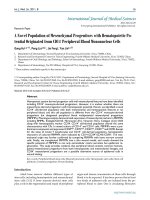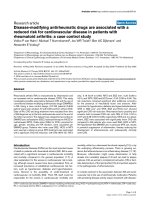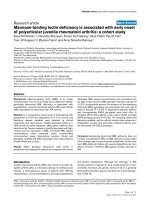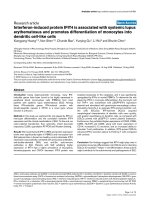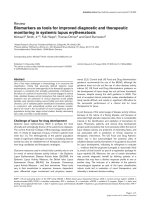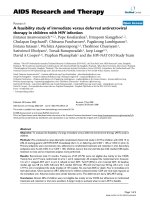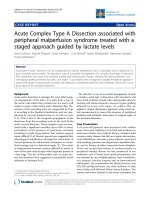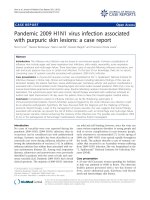Báo cáo y học: " Thymic stromal lymphopoietin (TSLP) is associated with allergic rhinitis in children with asthma" pot
Bạn đang xem bản rút gọn của tài liệu. Xem và tải ngay bản đầy đủ của tài liệu tại đây (410.31 KB, 10 trang )
RESEARCH Open Access
Thymic stromal lymphopoietin (TSLP) is
associated with allergic rhinitis in children
with asthma
Supinda Bunyavanich
1,2,5*
, Erik Melen
1,5,6,7
, Jemma B Wilk
9
, Mark Granada
10
, Manuel E Soto-Quiros
12
,
Lydiana Avila
12
, Jessica Lasky-Su
1,5
, Gary M Hunninghake
1,3,5
, Magnus Wickman
6,8
, Göran Pershagen
6
,
George T O’Connor
10,11
, Scott T Weiss
1,4,5
, Juan C Celedόn
1,3,4,5,13,14,15
Abstract
Background: Allergic rhinitis (AR) affects up to 80% of children with asthma and increases asthma severity. Thymic
stromal lymphopoietin (TSLP) is a key mediator of allergic inflammation. The role of the TSLP gene (TSLP) in the
pathogenesis of AR has not been studied.
Objective: To test for associations between variants in TSLP, TSLP-related genes, and AR in children with asthma.
Methods: We genotyped 15 single nucleotide polymorphisms (SNPs) in TSLP, OX40L, IL7R, and RXRa in three
independent cohorts: 592 asthmatic Costa Rican children and their parents, 422 nuclear families of North American
children with asthma, and 239 Swedish children with asthma. We tested for associations between these SNPs and
AR. As we previously reported sex-specific effects for TSLP, we performed overall and sex-stratified analyses. We
additionally performed secondary analyses for gene-by-gene interactions.
Results: Across the three cohorts, the T allele of TSLP SNP rs1837253 was undertransmitted in boys with AR and
asthma as compared to boys with asthma alone. The SNP was associated with reduced odds for AR (odds ratios
ranging from 0.56 to 0.63, with corresponding Fisher’s combined P value of 1.2 × 10
-4
). Our findings were
significant after accounting for multiple comparisons. SNPs in OX40L, IL7R, and RXRa were not consistently
associated with AR in children with asthma. There were nominally significant interactions between gene pairs.
Conclusions: TSLP SNP rs1837253 is associated with reduced odds for AR in boys with asthma. Our findings
support a role for TSLP in the pathogenesis of AR in children with asthma.
Introduction
Allergic rhinitis (AR) is a common chronic disease,
affecting 10-30% of adults and 40% of children [1].
Characterized by nasal congestion, i tching, rhinorrhea,
and sneezing, AR decr eases school and work productiv-
ity. AR is a risk factor for asthma exacerbations and
asthma-related hospitalization [2,3]. Up to 80% of chil-
dren with asthma have AR [4], and treatmen t of comor-
bid AR reduces the odds of asthma-related healthc are
by up to 80% [5]. A better understanding of the
pathophysiology of AR could decrease morbidity in asth-
matics and in children overall.
The role of thymic stromal lymphopoietin (TSLP) in
the pathogenesis of AR has not been extensively studied.
TSLP is an interleukin (IL)-7-like cytokine that t riggers
dendritic cells and mast cells to induce T helper (Th)2
inflammatory responses (Figure 1) [6,7]. The gene f or
TSLP (TSLP) is expressed by ep ithelial cells of the lung,
skin and gut [8]. In humans, TSLP has been linked to
the pathogenesis of asthma [9-11], atopic dermatitis [6],
and eosinophilic esophagitis [12]. A few in vitro and
murine studies with small sample size have examined
TSLP expression in allergic rhinitis (AR) [13-16]. To
date, there have been no genetic association studies of
TSLP and AR.
* Correspondence:
1
Channing Laboratory, Department of Medicine, Brigham and Women’s
Hospital, Boston, Massachusetts, USA
Full list of author information is available at the end of the article
Bunyavanich et al. Clinical and Molecular Allergy 2011, 9:1
/>CMA
© 2011 Bunyavanich et al; licensee BioM ed Central Ltd. This is an Open Access article distributed under the terms of the Creative
Commons Attribution License ( g/licenses/by/2.0), which permits unrestricted use , distribution, and
reproduction in any medium, provided the origi nal work is properly cited.
The effects of TSLP are influenced by its heterodi-
meric receptor, costimulatory molecules, transcriptional
regulators, and other cytokines (Figure 1). Therefore, we
were also interested in examining the association
between AR and genes related to TSLP,including
OX40L, IL7R,andRXRa. Express ed by antigen-present-
ing cells, OX40L is an essential costimulatory mediator
of TSLP-mediated Th2 responses [17,18]. Blockade of
OX40L inhibits TSLP-driven Th2 inflammatory cell
infiltration, cytokine secretion, and IgE production in
mouse lung and skin [19]. The receptor for TSLP is a
het erodimeric complex composed of TSLPR and IL7Ra
chains [20]. The TSLPR chain binds to TSLP at low
affinity but its combination with the IL7Ra chain results
in high-affinity binding and STAT5 activation [21,22].
The IL7Ra chain is encoded by IL7R.Thenuclear
receptors retinoid × receptor (RXR)a and RXRb act as
transcriptional repressors that inhibit TSLP gene expres-
sion in mouse skin keratinocyte models of atopic der-
matitis [23].
In this study, we report an analysis of association
between single nucleotide polymorphisms (SNPs) in
TSLP, OX40L, IL7R,andRXRa and AR in three inde-
pendent studies of children with asthma from Costa
Rica, North America, and Sweden. We chose to per-
form this study in children with asthma because AR
causes disproportionately high morbidity in children
with asthma, and AR is up to four times more preva-
lent in children w ith asthma [24]. We found that a
SNP in TSLP was associated with reduced odds for AR
in boys across the three cohorts of children with
asthma.
Methods
Ethics Statement
Written informed consent was obtained from study par-
ticipants and from parents of children in the cohorts.
The institutional review boards of Brigham & Women’s
Hospital, CAMP Study Centers, and Karolinska Institu-
tet approved the study protocols.
Study Populations
The Genetics of Asthma in Costa Rica
TheGeneticsofAsthmainCostaRicastudyincludes
616childrenages6-14yearswithasthmawhowere
recruited between February 2001 and March 2006 [4].
This population is a genetic isolate of mixed Spanish
and Amerindian descent with one of the world’s highest
rates o f asthma (27.4% of children aged 6-7 years [25]).
Questionnaires were sent to the parents of 13,125
schoolchildren enrolled in 113 schools in Costa Rica. Of
the 7,282 children whose parents returned question-
naires, 2,714 had asthma (defined as physician-diag-
nosed asthma and ≥2 respiratory symptoms or recurrent
asthma attacks in the past year). Of these 2,714 children,
616 had high probability of having ≥6 great-grandpar-
ents born i n the Central Valley of Co sta Rica (to ensure
descent from the founder population), and were willing
to participate along with their parents. Of these 616 par-
ent-child t rios, 24 were excluded because of inadequate
DNA quality, leaving 592 tr ios for genotyping and
analysis.
Childhood Asthma Management Program (CAMP)
CAMP is a multicenter North American clinical trial
designed to investigate the long-term effects of inhaled
anti-inflammatory medications in children with mild to
moderate asthma [26]. Participating children had asthma
defined by symptoms greater than 2 times per week, use
of an inhaled bronchodilator at least twice weekly or use
of daily medication for asthma, and increased airway
responsiveness to methacholine (PC
20
≤ 12.5 mg/ml).
Children with severe asthma or other clinically signifi-
cant medical conditions were excluded. Of the 1041
children enrolled in the original clinical trial, 968 chil-
dren and 1518 of their parents contributed DNA sam-
ples to the CAMP Genetics Ancillary Study [27].
Selection criteria for genome wide association study
(GWAS) genotyping were (a) self-described non-
Hispanic white ethnicity and (b) availability of sufficient
DNA for microarray hybridization; 422 children and
their parents met these criteria.
Children, Allergy, Milieu, Stockholm, Epidemiological Survey
(BAMSE)
BAMSE is a birth cohort study of allergy and environment.
4089 newborn infants were recruited between 1994 and
1996 from central and northwestern parts of Stockholm,
%PITHELIAL#ELLS
-AST#ELLS
43,0 43,02
),2α
)MMATURE$ENDRITIC#ELL
-ATURE$ENDRITIC#ELL
/8,
#LASS))-(#
4CELLRECEPTOR
/8
.AIVE
#$
4CELL
!CTIVATED
4H
#YTOKINES
!LLERGIC
)NFLAMMATION
)G%
282α
282β
4HCELL
Figure 1 TSLP is a key mediator of allergic inflammation.TSLP
binds to a heterodimeric receptor of TSLPR and IL7Ra chains. Its
induction of Th2 mediated inflammation requires costimulation by
OX40L binding to OX40. RXRa and RXRb act as transcriptional
regulators.
Bunyavanich et al. Clinical and Molecular Allergy 2011, 9:1
/>Page 2 of 10
Sweden [28]. At eight years o f age, all BAMSE children
were invited for clinical testing, and blood samples were
obtained from 2,480 children. DNA was extracted from
2,033 samples after exclusion of samples with too little
blood, lack of questionnaire data, or if parental consent to
genetic analysis of the sample was not obtained. All chil-
dren with a doctor’s diagnosis of asthma ever (n = 251)
underwent GWAS genotyping [29].
Phenotyping
Phenotypic data were collected from each participant in
Costa Rica at study entry, in CAMP at randomization,
and in BAMSE at one, two, four, and eight years of age.
AR was defined as naso-ocular symptoms apart from
colds in the past 12 months and ≥1 positive skin test
reaction (STR) to allergens in Costa Rica and CAMP,
and as naso-ocular symptoms in the past 12 months
and ≥1 positive allergen-specific IgE (Phadiatop
®
, Phadia
AB, Uppsala, Sweden) at eight years in BAMSE. These
definitions for AR are consistent with Allergic Rhinitis
and its Impact on Asthma (ARIA) 2008 guidelines [30].
We chose not to use a physician’sdiagnosistodefine
AR given greater variability associated with this defini-
tion. We c ompared allergen-sensitized AR and physi-
cian-diagnosed AR in Costa Rica in a previous study [4].
Genotyping
Using data from European Americans (CEU) in the
International HapMap p roject [31], we applied a link-
age-disequilibrium (LD)-tagging algorithm (minor
allele frequency ≥ 5% and r
2
≥ 0.8) to identify common
variation in TSLP, OX40L, IL7R, RXRa a nd their 10 kb
flanks. LD maps were plotted using Haploview [32].
We considered additional SNPs in TSLP to evaluate
reported functional variation (rs3806933) [33] and
those highlighted in previous studies of asthma
(rs1837253) [34]. A total of 21 SNPs were chosen for
genotyping in Costa Rican su bjects and their parents
using the Sequenom iPLEX p latform (Sequenom, San
Diego, CA) including 9 SNPs for TSLP and 4 SNPs
each for OX40L, IL7R,andRXRa. We chose Costa
Rica as our population for initial findings because of
greater power to detect associations in this cohort rela-
tive to CAMP and BAMSE (Table 1). All power
calculations were performed using Quanto v.1.2.4.
(University of Southern California, Los Angeles, CA).
Genome-wide SNP genotyping for CAMP subjects and
their parents was performed o n Illumina Human-
Hap550 Genotyping BeadChip (Illumina, Inc., San
Diego, CA). Genome-wide SNP genotyping for BAMSE
subjects was performed on Illumina Human 610-Quad
Beadchip (Illumina, Inc., San Diego, CA). Sixteen of the
CAMP GWAS SNPs and fifteen of the BAMSE GWAS
SNPs overlapped with those genotyped in Costa Rican
subjects and their parents. The 15 overlapping SNPs
were used to replicate our initial findings (Table 2). Of
these15SNPs,3wereinTSLP (rs1837253, rs2289276,
rs17551370), and 4 each were in OX40L (rs1234313,
rs10489267, r s10489266, rs1234315), IL7R (rs1494555,
rs10063294, rs2194225, rs6897932), and RXRa
(rs11185647, rs12339187, rs11185659, rs10881582). The
6 SNPs that were g enotyped in Costa Rica but not on
both the GWAS platforms had no significant association
with AR in Costa Rica. There were no differences in
SNP minor allele frequencies between boys and girls in
these cohorts.
In all study cohorts, duplicate ge notyping was per-
formed on approximately 5% of the sample to assess
genotype reproducibility. Genotype quality control was
assessed by <1% discordance rate, <5 Mendelian incon-
sistencies, and genotype completion rates >98% for all
loci. All SNPs included in analyses were in Hardy-Wein-
berg equilibrium (p > 0.01).
Of the 592 Costa Rican child-parent trios genotyped, 6
were excluded from this analysis because of Mendelian
inconsistencies, leaving 586 trios. Of the 422 nuclear
families in CAMP trios, 25 were excluded from this ana-
lysis because of Mendelian inconsistencies (n = 6) or
mis sing >5% of the genotypic data (n = 19), leaving 397
families. 12 children from BAMSE were excluded
because of duplicate genotyping or non-European ances-
try as determined by admixture mapping using principal
components analysis [29], leaving 239 children for this
analysis.
Statistical Analyses
We tested for association between SNPs in TSLP,
OX40L, IL7R, RXRa and AR in children with asthma.
Table 1 Power calculations for genetic association studies of AR in Costa Rica, CAMP, and BAMSE
Costa Rica (n = 592) CAMP (n = 422) BAMSE (n = 239)
Allele
Frequency
Power to detect
OR 1.5
Power to detect
OR 1.3
Power to detect
OR 1.5
Power to detect
OR 1.3
Power to detect
OR 1.5
Power to detect
OR 1.3
0.10 0.89 0.52 0.77 0.40 0.23 0.12
0.20 0.99 0.75 0.94 0.61 0.36 0.18
0.30 0.997 0.85 0.98 0.71 0.44 0.22
0.40 0.998 0.88 0.98 0.76 0.48 0.24
Bunyavanich et al. Clinical and Molecular Allergy 2011, 9:1
/>Page 3 of 10
Family-based association analyses were first conducted
under an additive genetic model in Costa Rican families
using the Pedigree-Based Association Test (PBAT) [35]
implemented in Helix Tree v6.4.3 (Golden Helix, Boze-
man, MT). An advantage of family-based association
testing is that it is robust against population stratifica-
tion and population admixture [36]. We then replicated
our findings from Costa Rica in the CAMP and BAMS E
cohorts. Family-based analysis using PBAT was per-
formed in CAMP. In BAMSE, associations between
SNPs and AR phenotypes were measured using the
Cochran-Armitage trend test in PLINK [37]. As we have
previously reported sex-specific effects for TSLP on
serum total IgE [38] and asthma [11], we also performed
sex-stratified analyses in all cohorts. Transmitted to
undertransmitted ratios (T:U) and odds ratio estim ates
for AR phe notypes were obtained using P LINK [37]. To
assess for joint evidence of association in the child-
based cohorts, P values were combined across Costa
Rica , CAMP, and BAMSE with Fisher’scombinedprob-
ability method [39]. Results were considered significant
only when consistent associations (i.e. same allele, same
direction of genetic effect) were observed in all three
populations with a Fisher’s combined P value of ≤ 8.0 ×
10
-4
(0.05/(21*3) to account for multiple testing of 21
SNPs and 3 strata (overall, male, female).
Tests for interaction between SNPs in TSLP, OX40L,
IL7R, RXRa were additionally performed u sing PBAT
given high interest in potential gene by gene interac-
tions. Based on our power calculations using Quanto
v.1.2.4 for gene by gene interactions, we recognized a
priori that our power to detect such interactions would
be insufficient. For example, to detect an interaction
between two SNPs each with minor allele frequency
0.40 causing a change in risk of 10%, our sample size
would ha ve to be 4229 parent-child trios. We therefore
limited our interaction testing to the cohort with most
subjects (Costa Ri ca, with 592 trios) and considered this
a secondary, exploratory analysis.
Results
The phenoty pic characteristics of children in the Costa
Rica, Childhood Asthma Management Program
(CAM P), and Children, Allergy, Milieu, Stockholm, Epi-
demiological Survey (BAMSE) study cohorts are shown
in Table 3. Consistent with the known gender distribu-
tion of asthma in childhoo d [40], all three cohorts had
more boys than girls. Children in Costa Rica had the
highest prevalence of AR.
The linkage disequilibrium (LD) patterns and minor
allele frequencies (MAF) fo r the TSLP SNPs genotyped
in all three cohorts are shown in Figure 2. There were
no major differences in MAFs and LD patterns among
the SNPs between the c ohorts. The LD patterns and
MAFs for the nine TSLP SNPs genotyped in Costa Rica
are shown in Figure 3. Consistent with our LD-tagging
approach, LD was generally not high between the SNPs
chosen for genotyping in Costa Rica.
The results for overall and se x-stratified association
testing of TSLP SNP rs1837253 and AR in Costa R ica,
CAMP, and BAMSE are shown in Table 4. The associa-
tion between rs1837253 and AR in all children (in ana-
lyses not stratified by sex) was significant in CAMP (P
value 0.003) but not in Costa Rica or BAMSE. In sex-
stratified analysis, the T allele of SNP rs1837253 was
associated with reduced odds for allergen-sensitized AR
in boys in all three cohorts, with P values ranging from
0.04 to 0.004 . Speci fically, the minor allel e of rs1837253
was undertransmitted in boys wi th AR and asthma as
compared to boys with asthma alone in all three
cohorts. The combined P value across cohorts met our
criteria for significance after accounting for multiple
testing, with Fisher’ s combined P value of 1.2 × 10
-4
.
Odds ratios (ORs) for these associations ranged from
0.56 to 0.63. In contrast to the observed results in
males, female-specific associations between rs1837253
and AR were inconsistent across cohorts.
The other TSLP SNPs and SNP s in OX40L, IL7R and
RXRa were not significantly associated with AR pheno-
types across cohorts (Table 5).
Tests for gene by gene interactions showed twelve
nominally significant inter actions between SNPs in all
gene pair combinations of TSLP,OX40L,RXRa and
IL7R except for between RXRa and IL7R (Table 6).
After accounting for 84 tests for interaction, none
remained significant after correction for multiple
Table 2 SNPs analyzed in Costa Rica, CAMP, and BAMSE
SNP Gene Position Allele Allele Frequency
Costa
Rica
CAMP BAMSE
rs1837253 TSLP chr5:110429771 T 0.24 0.21 0.27
rs17551370 TSLP chr5:110432084 A 0.10 0.13 0.15
rs2289276 TSLP chr5:110435406 T 0.30 0.27 0.29
rs1234313 OX40L chr1:171432870 A 0.38 0.32 0.34
rs10489267 OX40L chr1:171436775 A 0.14 0.06 0.07
rs10489266 OX40L chr1:171445076 G 0.08 0.11 0.10
rs1234315 OX40L chr1:171445086 T 0.65 0.46 0.48
rs1494555 IL7R chr5:35906947 G 0.47 0.34 0.26
rs6897932 IL7R chr5:35910332 T 0.16 0.24 0.32
rs10063294 IL7R chr5:35913262 G 0.60 0.48 0.42
rs2194225 IL7R chr5:35919561 C 0.37 0.42 0.42
rs11185647 RXRa chr9:136355649 A 0.41 0.29 0.26
rs12339187 RXRa chr9:136369148 G 0.19 0.17 0.17
rs11185659 RXRa chr9:136383204 T 0.22 0.20 0.21
rs10881582 RXRa chr9:136395899 A 0.34 0.23 0.20
CAMP: Childhood Asthma Management Program.
BAMSE: Children, Allergy, Milieu, Stockholm, Epidemiological Survey.
Bunyavanich et al. Clinical and Molecular Allergy 2011, 9:1
/>Page 4 of 10
comparisons (P value threshold for significance 0.05/84
interaction tests = 0.00060).
Discussion
This is the first study to examine genetic associations
between SNPs in TSLP and AR. This is also the first
study to concurrently examine associations betw een var-
iants in multiple TSLP-related genes (OX40L, IL7R,
RXRa) and AR. We found an inverse male-specific asso-
ciation b etween the T allele of SNP rs1837253 in TSLP
and AR in three independent cohorts of children with
asthma. As children with asthma are particularly vulner-
able to develop and suffer morbidity from AR , our find-
ings are of direct relevance to this population.
Our study contributes to a nascent literature on the
role of TSLP in AR. Prior work on TSLP has focused on
other allergic diseases [6,9 -12]. That TSLP could play a
role in AR is first suggested by our understanding of
TSLP and its ability to drive Th2 dominant inflamma-
tion. Second, a limited number of in vitro and murine
studies have reported increased TSLP expression in cell
cultures and nasal epithelium from AR patients
[13-16,19]. The significant association between a TSLP
variant and AR that we observed across multiple large
and d istinct cohorts supports that TSLP plays a role in
AR in humans, corroborates previous in vitro and mur-
ine studies, and supports our understanding of TSLP
driving allergic inflammation.
Table 3 Baseline phenotypic characteristics of children in Costa Rica, CAMP, and BAMSE
Variable Costa Rica
*
CAMP
*
BAMSE
All
(n = 592)
Boys
(n = 351)
Girls
(n = 241)
All
(n = 422)
Boys
(n = 266)
Girls
(n = 156)
All
(n = 239)
Boys
(n = 150)
Girls
(n = 89)
Age-Years 9.0 (1.8) 9.1 (1.9) 8.9 (1.7) 8.7 (2.1) 8.6 (2.1) 8.9 (2.1) 8.3 (0.5) 8.3 (0.5) 8.3 (0.4)
STR or allergen-specific IgE -
Any Positive
504
(85.4%)
200 (83.9%) 304 (87.1%) 370
(87.7%)
235 (88.4%) 135 (86.5%) 113
(47.3%)
78 (52%) 35 (39%)
Serum Total IgE - IU/ml 697 (867) 755 (911) 611 (792) 1095
(1920)
988 (1567) 1276
(2397)
n/a
†
n/a
†
n/a
†
Nasal symptoms in past year 543
(91.7%)
334 (90.3%) 230 (93.5%) 207
(49.1%)
135 (50.8%) 72 (46.2%) 76
(31.9%)
52 (34.9%) 24 (27.0%)
Allergic Rhinitis 474
(80.1%)
282 (80.3%) 192 (79.7%) 189
(44.8%)
124 (46.6%) 65 (41.7%) 64
(26.9%)
43 (28.9%) 21 (23.6%)
Values are presented as mean (standard deviation) or number (percentage).
STR = skin test reaction.
*Values are for index children in these family-based cohorts.
†
Data not collected in BAMSE.
-!&
-!&
-!&
#/34!2)#! #!-0 "!-3%
RS
RS
RS
0.00 0.10 0.20 0.30 0.40 0.50 0.60 0.70 0.80 0.90 1.00
Figure 2 LD plot of TSLP SNPs genotyped in Costa Rica, CAMP, and BAMSE. Pairwise correlation structure for TSLP SNPs genotyped in all
three cohorts.
Bunyavanich et al. Clinical and Molecular Allergy 2011, 9:1
/>Page 5 of 10
We found male-specific associations between TSLP
SNP rs1837253 and AR in children with asthma from
the Costa Rica, CAMP, and BAMSE studies. This SNP
was undertransmitted in boys wi th AR and asthma as
compared to in boys with asthma alone. Although this
SNP has previously been associated with asthma [11,34],
the associations with AR that we found cannot be attrib-
uted to as thma alone since all subjects in our study had
asthma. Our findings suggest an additional role for this
SNP in the pathogenesis of AR.
Our results were more statistically significant in boys
than in all children, despite reductions in power in the
sex-stratified analysis. T his suggests that the sign ificant
associations among males that we observed across the
cohorts were not merely due to the greater number of
boys in these cohorts. The gene for the TSLPR chain of
the heterodimeric TSLP receptor has a sex chromosome
location in humans (Xp22.3 and Yp11.3) [41], and th is
could partially explain a sex-specific mechanism for
TSLP. Sex-dependent hormonal regulation of transcrip-
tion is also possible. Sex-specific effects have been
observed for TSLP [11] and for other genes [42-44].
Our study’s findings are consistent with sex-specific
epidemiological observations for AR. Male children
become more sensitized to environmental allergens and
have higher serum total IgE levels [45,46]. Nasal fluid
allergen-specific IgE levels are higher in male than female
patients with seasonal AR [47]. A sex-stratified analysis
of inflammatory pathways using allergen-challenged CD4
+ cells from AR patients showed higher expression signa-
tures in males [47]. Sexual dimorphism has also been
noted in genetic linkage and association studies of se rum
total IgE [38,48]. Our findings expand on previous
reports of sexual dimorphism in allergic disease by iden-
tifying sex-specific effects of a genetic variant on AR.
Our laboratory previously reported a sex-specific asso-
ciation between rs2289276 and serum total IgE [38], and
between rs1827253 and asthma [11]. rs2289276 is pre-
dicted to affect an exonic splicing enhancer, while
rs1837253 is thought to disrupt a transcription factor
binding site [49]. SNP rs1837253 is located 5.7 kb
upstream of the TSLP transcription start site. A study
by Ha rada et al. conducted in human bronchial epithe-
lial suggested that a SNP in the TSLP promoter region
could serve as a binding site for transcription activ ati ng
protein (AP)-1, enhance AP-1 binding to regulatory ele-
ments, and lead to TSLP’s downstream effects [33]. Har-
ada et al. implicated rs3806933 as the functional SNP;
they did not study rs1837253, and rs1837253 is not in
LD with rs3806933 (Figure 3). We did not find an asso -
ciation between rs3806933 and AR, nor between
rs2289276 and AR. He et al. reported associations
between rs1837253 and protection from asthma, atopic
asthma, and airway hyperresponsiveness [34], and
rs991035
rs991035
rs1837253
rs17551370
rs10455025
rs3806933
rs2289276
rs2289277
rs11466749
rs2416258
0.00 0.10 0.20 0.30 0.40 0.50 0.60 0.70 0.80 0.90 1.00
Figure 3 LD plot of TSLP SNPs genotyped in Costa Rica.
Pairwise correlation structure for TSLP SNPs genotyped in Costa Rica.
Table 4 Association between TSLP SNP rs1837253 minor allele T* and allergic rhinitis in Costa Rica, CAMP, and BAMSE
Costa Rica CAMP BAMSE Combined
Subjects T:U
†
OR P value T:U OR P value OR P value Fisher’s P value
All children 104:122 0.85 0.18 50:81 0.62 0.003 0.72 0.089 0.003
Boys 59:93 0.63 0.004 32:55 0.58 0.007 0.56 0.04 1.2 × 10-4
Girls^ 45:29 1.55 0.08 18:26 0.69 0.11 1.02 0.48
*Allele frequency 0.24 in Costa Rica, 0.21 in CAMP, 0.27 in BAMSE.
†
T:U = ratio of transmitted to untransmitted alleles.
^Fisher’s combined P value not calculated because direction of effect inconsistent across females in these cohort.
Bunyavanich et al. Clinical and Molecular Allergy 2011, 9:1
/>Page 6 of 10
Hunninghake et al. reported sex-specific associations
between rs1837253 and protection from asthma in boys.
These studies corroborate rs1837253 as a SNP of inter-
est with a potential functional role.
Recognizing that TSLP interacts with other proteins to
affect Th2-driven inflammation, we implemented a com-
prehensive approach from the outset by also examining
for genetic associations between AR and SNPs in OX40L,
IL7R,andRXRa. We did not observe findings that were
consistent across cohorts for individual SNP associations
with AR. This may have been due to unexamined gene-
by-environment interactions. Shamim et al. previously
reported an association between two IL7R SN Ps and
inhalation allergy [50]. They did not perform replication
analyses in independent populations, and we did not find
associations between those SNPs and AR in our cohorts.
ItisthoughtthatRXRa and RXRb can influence tran-
scription of TSLP, but neither has been previously stu-
died in subjects with AR [23]. The RXRa SNPs we chose
to genotype capture 96% of the HapMap SNPs with MAF
≥ 10% in RXRa and its 10 kb flanks in the CEU popula-
tion with r
2
≥ 0.8, so our lack of findings for RXRa was
unlikely due to inadequate genotypic coverage [32]. Inter-
estingly, our tests for gene by gene interaction among
TSLP, OX40L, RXRa and IL7R in Costa Rican subjects
demonstrated nominally signif icant results between SNPs
in all gene pairs, except for between RXRa and IL7R.
Lack of gene by gene interaction between RXRa and
IL7R would be biolog ically consistent with their
physically disparate roles as transcriptional regulator of
TSLP and receptor for TSLP, respectively. Further gene
by gene analy ses with larger sample size could overcome
the power limitations we faced.
Our study has additional limitations. First, our findings
do not elucidate a specific mechanism. SNP rs1837253 is
not in LD with other HapMap SNPs and has the poten-
tial to represent a functio nal SNP itself. Our work pro-
vides a specific direction for functional studies that could
focus on transcriptional regulators of TSLP . Second,
some of our findings in Costa Ricans may be mainly
applicable to them and certain Hispanic subgroups. How-
ever, we replicated our main finding in CAMP and
BAMSE, and previous findings in Costa Rica have been
applicable to children of other ethnicities [51,52]. Family-
based testing is also robust against population stratifica-
tion and population admixture [36]. L astly, we focused
on AR in children with asthma, and it is possible that dis-
tinct associations could be found if we examined cohorts
with AR only. However, our findings are relevant to a
group of children at high risk for AR.
Conclusions
In summary, we found that the T allele of TSLP SNP
rs1837253 was associated with reduced odds for AR in
three independent cohorts of children with asthma. The
association was sex-specific, as it was signifi cant in males
but not females. Our work highlights that TSLP likely plays
a role in the pathogenesis of AR in chil dren with asthma.
Table 5 Analysis of association between TSLP, RXRa, IL7R, OX40L SNPs and AR in Costa Rica, CAMP, and BAMSE
Costa Rica CAMP BAMSE
P value P value P value
SNP Gene Allele Allele Frequency All Boys Girls Allele Frequency All Boys Girls Allele Frequency All Boys Girls
rs1837253 TSLP T 0.24 0.18 0.004 0.08 0.21 0.003 0.007 0.11 0.27 0.09 0.04 0.48
rs17551370 TSLP A 0.10 0.77 0.95 0.71 0.13 0.31 0.32 0.42 0.15 0.03 0.25 0.03
rs2289276 TSLP T 0.30 0.12 0.60 0.06 0.27 0.07 0.09 0.25 0.29 0.38 0.12 0.14
rs1234313 OX40L A 0.38 0.26 0.10 0.81 0.32 0.007 0.03 0.048 0.34 0.04 0.03 0.29
rs10489267 OX40L A 0.14 0.24 0.07 0.70 0.06 0.19 0.43 0.13 0.07 0.40 0.29 0.31
rs10489266 OX40L G 0.08 0.16 0.13 0.69 0.11 0.36 0.27 0.42 0.10 0.25 0.21 0.48
rs1234315 OX40L T 0.65 0.12 0.57 0.07 0.46 0.03 0.09 0.08 0.48 0.47 0.38 0.44
rs11185647 RXRa A 0.41 0.53 0.76 0.54 0.29 0.19 0.046 0.25 0.26 0.42 0.18 0.07
rs12339187 RXRa G 0.19 0.61 0.88 0.30 0.17 0.28 0.45 0.21 0.17 0.12 0.04 0.36
rs11185659 RXRa T 0.22 0.74 0.80 0.39 0.20 0.43 0.21 0.22 0.21 0.05 0.02 0.49
rs10881582 RXRa A 0.34 0.34 0.75 0.25 0.23 0.42 0.45 0.33 0.21 0.17 0.24 0.02
rs1494555 IL7R G 0.47 0.74 0.49 0.77 0.34 0.38 0.43 0.20 0.26 0.04 0.13 0.08
rs6897932 IL7R T 0.16 0.31 0.90 0.08 0.24 0.09 0.16 0.18 0.32 0.04 0.02 0.42
rs10063294 IL7R G 0.60 0.85 0.80 0.55 0.48 0.36 0.36 0.13 0.42 0.05 0.11 0.13
rs2194225 IL7R C 0.37 0.26 0.60 0.25 0.42 0.22 0.14 0.45 0.42 0.45 0.20 0.17
Bunyavanich et al. Clinical and Molecular Allergy 2011, 9:1
/>Page 7 of 10
Table 6 SNP by SNP Interaction Test P values in Costa Rica
Gene TSLP TSLP TSLP OX40L OX40L OX40L OX40L RXRa RXRa RXRa RXRa IL7R IL7R IL7R IL7R
SNP rs1837253 rs17551370 rs2289276 rs1234313 rs10489267 rs10489266 rs1234315 rs11185647 rs12339187 rs11185659 rs10881582 rs1494555 rs6897932 rs10063294 rs2194225
TSLP rs1837253 NS* NS NS NS NS NS NS NS 0.00062 0.0049 0.0033 NS
TSLP rs17551370 NS NS NS NS 0.036 NS NS NS NS NS NS NS
TSLP rs2289276 NS NS 0.034 NS NS NS NS NS NS 0.016 NS NS
OX40L rs1234313 NS 0.046 0.033 0.0040 NS NS NS NS
OX40L rs10489267 0.021 NS NS NS NS 0.018 NS NS
OX40L rs10489266 NS NS NS NS NS NS NS 0.043
OX40L rs1234315 NS NS NS NS NS NS NS NS
RXRa rs11185647 NS NS NS NS
RXRa rs12339187 NS NS NS NS
RXRa rs11185659 NS NS NS NS
RXRa rs10881582 NS NS NS NS
IL7R rs1494555
IL7R rs6897932
IL7R rs10063294
IL7R rs2194225
*NS = non-significant.
Bunyavanich et al. Clinical and Molecular Allergy 2011, 9:1
/>Page 8 of 10
Acknowledgements
We thank all subjects for their participation in the Genetics of Asthma in
Costa Rica, CAMP, and BAMSE studies. We acknowledge the CAMP
investigators and research team, supported by NHLBI, for collection of CAMP
Genetic Ancillary Study data. All work on data collected from the CAMP
Genetic Ancillary Study was conducted at the Channing Laboratory of the
Brigham and Women’s Hospital under appropriate CAMP policies and
human subject’s protections. This work was supported by the National
Institute of Health [Grants R37 HL66289, U01 HL075419, P01 HL083069, T32
HL007427]; the Swedish Research Council; Stockholm County Council; Centre
for Allergy Research, Karolinska Institutet; Swedish Heart Lung Foundation;
Swedish Fulbright Commission; Riksbankens Jubileumsfond; Erik Rönnberg
Scholarship; GABRIEL contract number 018996 under Integrated Program
LSH-2004-1.2.5-1; the Wellcome Trust [WT084703MA].
Author details
1
Channing Laboratory, Department of Medicine, Brigham and Women’s
Hospital, Boston, Massachusetts, USA.
2
Division of Rheumatology,
Immunology and Allergy, Department of Medicine, Brigham and Women’s
Hospital, Boston, Massachusetts, USA.
3
Division of Pulmonary and Critical
Care Medicine, Department of Medicine, Brigham and Women’s Hospital,
Boston, Massachusetts, USA.
4
Center for Genomic Medicine, Department of
Medicine, Brigham and Women’s Hospital, Boston, Massachusetts, USA.
5
Harvard Medical School, Boston, Massachusetts, USA.
6
Institute of
Environmental Medicine, Karolinska Institutet, Stockholm, Sweden.
7
Astrid
Lindgren Children’s Hospital, Karolinska University Hospital, Stockholm,
Sweden.
8
Sachs Children’s Hospital, Stockholm, Sweden.
9
Department of
Neurology, Department of Medicine, Boston University School of Medicine,
Boston, Massachusetts, USA.
10
Pulmonary Medicine, Department of Medicine,
Boston University School of Medicine, Boston, Massachusetts, USA.
11
The
National Heart, Lung, and Blood Institute’s Framingham Heart Study,
Framingham, Massachusetts, USA.
12
Division of Pediatric Pulmonology,
Hospital Nacional de Niños, San José, Costa Rica.
13
Division of Pulmonary
Medicine, Allergy, and Immunology, Children’s Hospital of Pittsburgh of the
University of Pittsburgh Medical Center, Pittsburgh, Pennsylvania, USA.
14
Department of Internal Medicine, University of Pittsburgh School of
Medicine, Pittsburgh, Pennsylvania, USA.
15
Department of Human Genetics,
University of Pittsburgh Graduate School of Public Health, Pittsburgh,
Pennsylvania, USA.
Authors’ contributions
SB contributed to the study design, analyzing the data, and writing the
manuscript. EM contributed to analyzing the data and manuscript editing.
JBW contributed to analyzing the data and manuscript editing. MG
contributed to analyzing the data and manuscript editing. MS contributed to
patient recruitment and manuscript editing. LA contributed to patient
recruitment and manuscript editing. JLS contributed to analyzing the data
and manuscript editing. GH contributed to the study design and manuscript
editing. MW contributed to patient recruitment and manuscript editing. GP
contributed to patient recruitment and manuscript editing. GTO contributed
to patient recruitment and manuscript editing. SW contributed to patient
recruitment and manuscript editing. JCC contributed to the study design,
patient recruitment and writing the manuscript. All authors read and
approved the final manuscript.
Competing interests
The authors declare that they have no competing interests.
Received: 27 October 2010 Accepted: 18 January 2011
Published: 18 January 2011
References
1. Meltzer EO, Blaiss MS, Derebery MJ, Mahr TA, Gordon BR, Sheth KK, Simmons AL,
Wingertzahn MA, Boyle JM: Burden of allergic rhinitis: results from the
Pediatric Allergies in America survey. J Allergy Clin Immunol 2009, 124:S43-70.
2. Thomas M, Kocevar VS, Zhang Q, Yin DD, Price D: Asthma-related health
care resource use among asthmatic children with and without
concomitant allergic rhinitis. Pediatrics 2005, 115:129-134.
3. Sazonov Kocevar V, Thomas J, Jonsson L, Valovirta E, Kristensen F, Yin DD,
Bisgaard H: Association between allergic rhinitis and hospital resource
use among asthmatic children in Norway. Allergy 2005, 60:338-342.
4. Bunyavanich S, Soto-Quiros ME, Avila L, Laskey D, Senter JM, Celedon JC:
Risk factors for allergic rhinitis in Costa Rican children with asthma.
Allergy 2010, 65(2):256-63, Epub 2009 Oct 1.
5. Corren J, Manning BE, Thompson SF, Hennessy S, Strom BL: Rhinitis
therapy and the prevention of hospital care for asthma: a case-control
study. J Allergy Clin Immunol 2004, 113:415-419.
6. Soumelis V, Reche PA, Kanzler H, Yuan W, Edward G, Homey B, Gilliet M,
Ho S, Antonenko S, Lauerma A, et al: Human epithelial cells trigger
dendritic cell mediated allergic inflammation by producing TSLP. Nat
Immunol 2002, 3:673-680.
7. Allakhverdi Z, Comeau MR, Jessup HK, Yoon BR, Brewer A, Chartier S,
Paquette N, Ziegler SF, Sarfati M, Delespesse G: Thymic stromal
lymphopoietin is released by human epithelial cells in response to
microbes, trauma, or inflammation and potently activates mast cells. J
Exp Med 2007, 204:253-258.
8. Liu YJ: TSLP in epithelial cell and dendritic cell cross talk. Adv Immunol
2009, 101:1-25.
9. Ying S, O’Connor B, Ratoff J, Meng Q, Mallett K, Cousins D, Robinson D,
Zhang G, Zhao J, Lee TH, Corrigan C: Thymic stromal lymphopoietin
expression is increased in asthmatic airways and correlates with
expression of Th2-attracting chemokines and disease severity. J Immunol
2005, 174:8183-8190.
10. Ying S, O’Connor B, Ratoff J, Meng Q, Fang C, Cousins D, Zhang G, Gu S,
Gao Z, Shamji B, et al: Expression and cellular provenance of thymic
stromal lymphopoietin and chemokines in patients with severe asthma
and chronic obstructive pulmonary disease. J Immunol 2008,
181:2790-2798.
11. Hunninghake GM, Soto-Quiros ME, Avila L, Kim HP, Lasky-Su J, Rafaels N,
Ruczinski I, Beaty TH, Mathias RA, Barnes KC, et al: TSLP polymorphisms are
associated with asthma in a sex-specific fashion. Allergy 2010,
65(12):1566-75.
12. Rothenberg ME, Spergel JM, Sherrill JD, Annaiah K, Martin LJ, Cianferoni A,
Gober L, Kim C, Glessner J, Frackelton E, et al: Common variants at 5q22
associate with pediatric eosinophilic esophagitis.
Nat Genet 2010,
42:289-291.
13.
Mou Z, Xia J, Tan Y, Wang X, Zhang Y, Zhou B, Li H, Han D:
Overexpression of thymic stromal lymphopoietin in allergic rhinitis. Acta
Otolaryngol 2008, 1-5.
14. Miyata M, Hatsushika K, Ando T, Shimokawa N, Ohnuma Y, Katoh R, Suto H,
Ogawa H, Masuyama K, Nakao A: Mast cell regulation of epithelial TSLP
expression plays an important role in the development of allergic
rhinitis. Eur J Immunol 2008, 38:1487-1492.
15. Kamekura R, Kojima T, Koizumi JI, Ogasawara N, Kurose M, Go M,
Harimaya A, Murata M, Tanaka S, Chiba H, et al: Thymic stromal
lymphopoietin enhances tight-junction barrier function of human nasal
epithelial cells. Cell Tissue Res 2009, 338(2):283-93, Epub 2009 Sep 9.
16. Zhu DD, Zhu XW, Jiang XD, Dong Z: Thymic stromal lymphopoietin
expression is increased in nasal epithelial cells of patients with mugwort
pollen sensitive-seasonal allergic rhinitis. Chin Med J (Engl) 2009,
122:2303-2307.
17. Ito T, Wang YH, Duramad O, Hori T, Delespesse GJ, Watanabe N, Qin FX,
Yao Z, Cao W, Liu YJ: TSLP-activated dendritic cells induce an
inflammatory T helper type 2 cell response through OX40 ligand. J Exp
Med 2005, 202:1213-1223.
18. Wang YH, Liu YJ: Thymic stromal lymphopoietin, OX40-ligand, and
interleukin-25 in allergic responses. Clin Exp Allergy 2009, 39:798-806.
19. Seshasayee D, Lee WP, Zhou M, Shu J, Suto E, Zhang J, Diehl L, Austin CD,
Meng YG, Tan M, et al: In vivo blockade of OX40 ligand inhibits thymic
stromal lymphopoietin driven atopic inflammation. J Clin Invest 2007,
117:3868-3878.
20. Reche PA, Soumelis V, Gorman DM, Clifford T, Liu M, Travis M, Zurawski SM,
Johnston J, Liu YJ, Spits H, et al: Human thymic stromal lymphopoietin
preferentially stimulates myeloid cells. J Immunol 2001, 167:336-343.
21. Pandey A, Ozaki K, Baumann H, Levin SD, Puel A, Farr AG, Ziegler SF,
Leonard WJ, Lodish HF: Cloning of a receptor subunit required for
signaling by thymic stromal lymphopoietin. Nat Immunol 2000, 1:59-64.
22. Park LS, Martin U, Garka K, Gliniak B, Di Santo JP, Muller W, Largaespada DA,
Copeland NG, Jenkins NA, Farr AG, et al: Cloning of the murine thymic
stromal lymphopoietin (TSLP) receptor: Formation of a functional
heteromeric complex requires interleukin 7 receptor. J Exp Med 2000,
192:659-670.
Bunyavanich et al. Clinical and Molecular Allergy 2011, 9:1
/>Page 9 of 10
23. Li M, Messaddeq N, Teletin M, Pasquali JL, Metzger D, Chambon P: Retinoid
× receptor ablation in adult mouse keratinocytes generates an atopic
dermatitis triggered by thymic stromal lymphopoietin. Proc Natl Acad Sci
USA 2005, 102:14795-14800.
24. Meltzer EO, Szwarcberg J, Pill MW: Allergic rhinitis, asthma, and
rhinosinusitis: diseases of the integrated airway. J Manag Care Pharm
2004, 10:310-317.
25. Pearce N, Ait-Khaled N, Beasley R, Mallol J, Keil U, Mitchell E, Robertson C:
Worldwide trends in the prevalence of asthma symptoms: phase III of
the International Study of Asthma and Allergies in Childhood (ISAAC).
Thorax 2007, 62:758-766.
26. The Childhood Asthma Management Program (CAMP): design, rationale,
and methods. Childhood Asthma Management Program Research
Group. Control Clin Trials 1999, 20:91-120.
27. Himes BE, Hunninghake GM, Baurley JW, Rafaels NM, Sleiman P,
Strachan DP, Wilk JB, Willis-Owen SA, Klanderman B, Lasky-Su J, et al:
Genome-wide association analysis identifies PDE4D as an asthma-
susceptibility gene. Am J Hum Genet 2009, 84:581-593.
28. Melen E, Nyberg F, Lindgren CM, Berglind N, Zucchelli M, Nordling E,
Hallberg J, Svartengren M, Morgenstern R, Kere J, et al: Interactions
between glutathione S-transferase P1, tumor necrosis factor, and traffic-
related air pollution for development of childhood allergic disease.
Environ Health Perspect 2008, 116:1077-1084.
29. Moffatt M, Gut IG, Demenais F, Strachan DP, Bouzigon E, Heath S, von
Mutius E, Farrall M, Lathrop M, Cookson WOCM, the GABRIEL consortium: A
large-scale, consortium-based genome-wide association study of
asthma. N Engl J Med 2010, 363:1211-1221.
30. Bousquet J, Khaltaev N, Cruz AA, Denburg J, Fokkens WJ, Togias A,
Zuberbier T, Baena-Cagnani CE, Canonica GW, van Weel C, World Health
Organization; GA(2)LEN; AllerGen, et al: Allergic Rhinitis and its Impact on
Asthma (ARIA) 2008 update (in collaboration with the World Health
Organization, GA(2)LEN and AllerGen). Allergy 2008, 63:8-160.
31. The International HapMap Project. Nature 2003, 426:789-796.
32. Barrett JC, Fry B, Maller J, Daly MJ: Haploview: analysis and visualization of
LD and haplotype maps. Bioinformatics 2005, 21:263-265.
33. Harada M, Hirota T, Jodo AI, Doi S, Kameda M, Fujita K, Miyatake A,
Enomoto T, Noguchi E, Yoshihara S, et al: Functional analysis of the
thymic stromal lymphopoietin variants in human bronchial epithelial
cells. Am J Respir Cell Mol Biol 2009, 40:368-374.
34. He JQ, Hallstrand TS, Knight D, Chan-Yeung M, Sandford A, Tripp B,
Zamar D, Bosse Y, Kozyrskyj AL, James A, et al: A thymic stromal
lymphopoietin gene variant is associated with asthma and airway
hyperresponsiveness. J Allergy Clin Immunol 2009, 124:222-229.
35. Lange C, DeMeo D, Silverman EK, Weiss ST, Laird NM: PBAT: tools for
family-based association studies. Am J Hum Genet 2004, 74:367-369.
36. Laird NM, Lange C: Family-based designs in the age of large-scale gene-
association studies. Nat Rev Genet 2006, 7:385-394.
37. Purcell S, Neale B, Todd-Brown K, Thomas L, Ferreira MA, Bender D, Maller J,
Sklar P, de Bakker PI, Daly MJ, Sham PC: PLINK: a tool set for whole-
genome association and population-based linkage analyses. Am J Hum
Genet 2007, 81:559-575.
38. Hunninghake GM, Lasky-Su J, Soto-Quiros ME, Avila L, Liang C, Lake SL,
Hudson TJ, Spesny M, Fournier E, Sylvia JS, et al: Sex-stratified linkage
analysis identifies a female-specific locus for IgE to cockroach in Costa
Ricans. Am J Respir Crit Care Med 2008, 177:830-836.
39. Fisher RA: Statistical Methods for Research Workers Edinburgh: Oliver and
Boyd; 1932.
40. Almqvist C, Worm M, Leynaert B: Impact of gender on asthma in
childhood and adolescence: a GA2LEN review. Allergy 2008, 63:47-57.
41. Maglott D, Ostell J, Pruitt KD, Tatusova T: Entrez Gene: gene-centered
information at NCBI. Nucleic Acids Res 2007, 35:D26-31.
42. Patsopoulos NA, Tatsioni A, Ioannidis JP: Claims of sex differences: an
empirical assessment in genetic associations. JAMA 2007, 298:880-893.
43. Raby BA, Lazarus R, Silverman EK, Lake S, Lange C, Wjst M, Weiss ST:
Association of vitamin D receptor gene polymorphisms with childhood
and adult asthma. Am J Respir Crit Care Med 2004, 170:1057-1065.
44. Karjalainen J, Nieminen MM, Aromaa A, Klaukka T, Hurme M: The IL-1beta
genotype carries asthma susceptibility only in men. J Allergy Clin
Immunol 2002, 109:514-516.
45. Guilbert TW, Morgan WJ, Zeiger RS, Bacharier LB, Boehmer SJ, Krawiec M,
Larsen G, Lemanske RF, Liu A, Mauger DT, et al: Atopic characteristics of
children with recurrent wheezing at high risk for the development of
childhood asthma. J Allergy Clin Immunol 2004, 114:1282-1287.
46. Uekert SJ, Akan G, Evans MD, Li Z, Roberg K, Tisler C, Dasilva D, Anderson E,
Gangnon R, Allen DB, et al: Sex-related differences in immune
development and the expression of atopy in early childhood. J Allergy
Clin Immunol 2006, 118:1375-1381.
47. Barrenas F, Andersson B, Cardell LO, Langston M, Mobini R, Perkins A,
Soini J, Stahl A, Benson M: Gender differences in inflammatory proteins
and pathways in seasonal allergic rhinitis. Cytokine 2008, 42:325-329.
48. Raby BA, Soto-Quiros ME, Avila L, Lake SL, Murphy A, Liang C, Fournier E,
Spesny M, Sylvia JS, Verner A, et al: Sex-specific linkage to total serum
immunoglobulin E in families of children with asthma in Costa Rica.
Hum Mol Genet 2007, 16:243-253.
49. Conde L, Vaquerizas JM, Dopazo H, Arbiza L, Reumers J, Rousseau F,
Schymkowitz J, Dopazo J: PupaSuite: finding functional single nucleotide
polymorphisms for large-scale genotyping purposes. Nucleic Acids Res
2006, 34:W621-625.
50. Shamim Z, Muller K, Svejgaard A, Poulsen LK, Bodtger U, Ryder LP:
Association between genetic polymorphisms in the human interleukin-7
receptor alpha-chain and inhalation allergy. Int J Immunogenet 2007,
34:149-151.
51. Hersh CP, Raby BA, Soto-Quiros ME, Murphy AJ, Avila L, Lasky-Su J, Sylvia JS,
Klanderman BJ, Lange C, Weiss ST, Celedon JC: Comprehensive testing of
positionally cloned asthma genes in two populations. Am J Respir Crit
Care Med 2007, 176:849-857.
52. Hunninghake GM, Soto-Quiros ME, Avila L, Su J, Murphy A, Demeo DL,
Ly NP, Liang C, Sylvia JS, Klanderman BJ, et al: Polymorphisms in IL13,
total IgE, eosinophilia, and asthma exacerbations in childhood. J Allergy
Clin Immunol 2007, 120:84-90.
doi:10.1186/1476-7961-9-1
Cite this article as: Bunyavanich et al.: Thymic stromal lymphopoietin
(TSLP) is associated with allergic rhinitis in children with asthma. Clinical
and Molecular Allergy 2011 9:1.
Submit your next manuscript to BioMed Central
and take full advantage of:
• Convenient online submission
• Thorough peer review
• No space constraints or color figure charges
• Immediate publication on acceptance
• Inclusion in PubMed, CAS, Scopus and Google Scholar
• Research which is freely available for redistribution
Submit your manuscript at
www.biomedcentral.com/submit
Bunyavanich et al. Clinical and Molecular Allergy 2011, 9:1
/>Page 10 of 10
